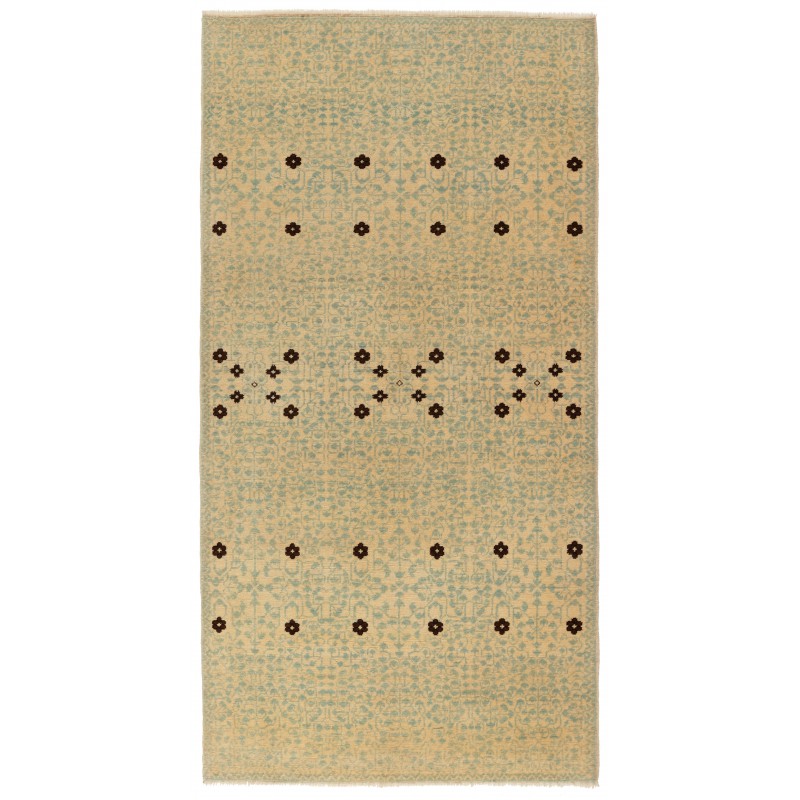
- Stock: In Stock
- Model: C50273
- サイズ: 167cm x 87cm
この絨毯の情報は、Völker, Angela, Die orientalischen Knüpfteppiche das MAK, Vienna: Böhlau, 2001: 42–5という本から取得されました。この中央の星を持つ絨毯は、エジプトのカイロにあるマムルーク・スルタンの16世紀初頭のデザインです。ウィーンのMAK(応用美術博物館)に展示されています。その印象的なサイズ、素材、デザインの質から見ると、このカーペットは高度な宮廷工房の製品であり、おそらく最後のマムルーク朝の後期に制作されたものです。使用された色の量からは、1500年頃のより早い時期を示しており、葉巻のつるや特徴的な傘の葉を持つ繊細な植物の境界線は、より後の時期を示唆しています。1517年にオスマン帝国がマムルーク朝を征服しましたが、カイロのカーペット工房はマムルーク様式で作品を製作し続けました。
カイロで制作された初期の絨毯を読み解くことは、まったく異なる種類の挑戦を提供します。カイロの絨毯は、限られた色彩、対称的な結び目、異常なS撚りのウールの構造(イスラム世界のほぼすべてで使用されるZ撚りのウールが一般的です)によって特徴付けられ、オスマン帝国が1517年にマムルーク朝を征服した後、デザインに急激な変化がありました。シモネッティ・カーペットは征服の後に織られた可能性がありますが、マムルーク朝の「古い」15世紀のスタイルを示しています。このカーペットは長くて細く、エジプトの標準サイズのローラービーム織機で織られ、さまざまな長さの絨毯を生産することができます。A-B-C-B-Aのパターンでデザインされた5つの主要な焦点エリアから成り、つまり、第1および第5エリア、第2および第4エリアはペアになっており、中央部分は独自のデザインです。これらの5つの焦点エリアをメダリオンと簡単に呼ぶことができますが、レイアウトとディテールの両方で幾何学的であり、そのスタイル(織られた日付とは異なる)は、メダリオンの形式を生み出すカーペットデザインの革命よりも前のものです。マムルークの絨毯のデザインと色彩は、昆虫由来の赤、青、緑、そして時に黄色の異常な組み合わせを特徴としており、ほとんど無染色の白色はほとんどなく、特にヨーロッパで、このようなマムルークの絨毯は微妙な色合い、非常に詳細なデザイン、小さな模様で構成されたモザイクのような配置が、アナトリアのより粗く織られ、鮮やかな色合いのウシャク・メダリオン・カーペットに対する魅力的な選択肢を提供していました。伝統的な幾何学的なマムルークのデザインでの絨毯の織りは、おそらく17世紀まで続いたようですが、16世紀半ばごろを境に、カイロの織工たちは、マムルークの伝統的な材料、技法、色彩を使用しながら、イスタンブールのオスマン・スルタンの宮廷で生まれた最新のスタイルを反映した、まったく新しい種類の絨毯を作り始めました。この絨毯のデザインは、当社のデザイナーによって解釈され、ソフトな色合いが使用されています。
The source of the rug comes from the book Völker, Angela, Die orientalischen Knüpfteppiche das MAK, Vienna: Böhlau, 2001: 42–5. This rug with the central star was designed in the early 16th-century rug by Mamluk Sultane of Cairo, Egypt. It is exhibited at MAK – Museum of Applied Arts, Vienna Austria. As its impressive size, materials, and design quality suggest, the carpet is a product of an accomplished court workshop and likely dates from the late period of the last Mamluk dynasty. The quantity of the colors used speaks for an earlier date around 1500; the delicate vegetal border with leaf tendrils and the characteristic umbrella leaves rather point to a later date. In 1517, the Ottomans conquered the Mamluk Empire, but Cairo’s carpet workshops still produced pieces until the mid-16th century in a post-Mamluk style.
全部で4色使っています。
- Natural Wool Color 320 (羊そのままの色)
- Opal 533 (ヘナ - 藍)
- Natural Wool Color 37 (羊そのままの色)
- Dark Brawn 316 (羊そのままの色)
上の番号は私たちのカラーコードです。()の中は、主な草木染めの材料です。
